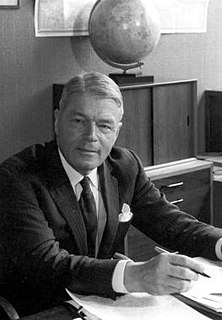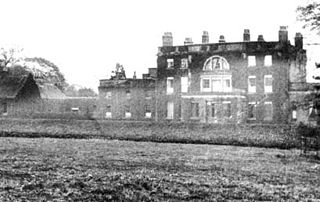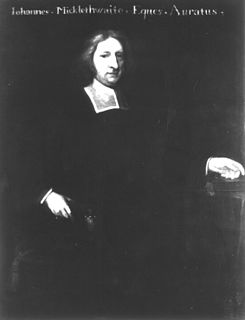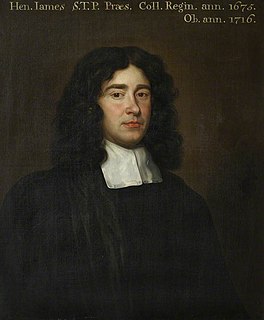Related Research Articles
Christopher Hatton, 1st Baron Hatton KB PC FRS was a distant relation of the Elizabethan politician, Sir Christopher Hatton and a prominent Royalist during the reign of King Charles I of England.

Sir Cyril Astley Clarke, KBE, FRCP, FRCOG, (Hon) FRC Path, FRS was a British physician, geneticist and lepidopterist. He was honoured for his pioneering work on prevention of Rh disease of the newborn, and also for his work on the genetics of the Lepidoptera.

Charles Chauncy was an Anglo-American Congregational clergyman, educator, and secondarily, a physician.

Frank Nicholls was a physician. He was elected a Fellow of the Royal Society in 1728. He was made reader of anatomy at Oxford University when young and moved to London in the 1730s.

William Battie was an English physician who published in 1758 the first lengthy book on the treatment of mental illness, A Treatise on Madness, and by extending methods of treatment to the poor as well as the affluent, helped raise psychiatry to a respectable specialty. He was President of the Royal College of Physicians in 1764.

Anthony Askew (1722–1774) was an English physician and is best known for having been a book collector. His collection was purchased by the British Museum and books purchased by George III of Great Britain were added to the King's Library.

Sir Edward Wilmot, 1st Baronet (1693–1786) was a surgeon and physician to both George II and George III of Great Britain.

Sir John Micklethwaite M.D. (1612–1682) was an English physician, who attended Charles II. He was President of the Royal College of Physicians.

Sir George Burrows, Bt, PRS, was an English physician and President of the Royal College of Physicians.

William Briggs was an English physician and oculist.

Arthur Farre FRS was an English obstetric physician.
Sir Alexander Fraizer, MD FRS, was a Scottish physician.
Sir Thomas Witherley MD (1618–1694) was Physician in Ordinary to King Charles II, Second Physician to King James II, and President of the Royal College of Physicians from 1684 to 1687.
Edward Browne, FRS was a British physician, and president of the College of Physicians.
Sir Anthony Morgan (1621–1668) was an English Royalist politician and soldier. In the English Civil War he was first a Royalist captain and then in 1646 changed sides and joined the Parliamentary army. He was a captain in Ireton's horse (cavalry) in Ireland in 1649 and had risen to the rank of major by 1662. He was a Member of Parliament for the Irish constituency of Wicklow and Kildare in the parliaments of 1654 to 1658, and represented the Irish constituency of Meath and Louth in 1659. The Lord Protector Oliver Cromwell knighted him in 1656 and after the Restoration, he was also knighted by King Charles II in 1660. He was a commissioner of the English auxiliaries in France and an original member of the Royal Society in 1663.

Richard Warren (1731–1797) was an English physician, a prominent society doctor in the later 18th century.
Walter Needham was an English physician, known as an anatomist.
Samuel Cradock, B.D. (1621?–1706) was a nonconformist tutor, who was born about 1621. He was an elder brother of Zachary Cradock.

Henry James was an English clergyman and academic at the University of Cambridge, who served as President of Queens' College, Cambridge 1675–1717 and Regius Professor of Divinity 1699–1717.

George Castle, was an English physician.
References
- 1 2 3 4 Goodwin 1887.
- ↑ Diary, ed. Bright, ii. 205.
- ↑ "Clarke, Timothy (CLRK668T)". A Cambridge Alumni Database. University of Cambridge.
- Attribution
![]() This article incorporates text from a publication now in the public domain : Goodwin, Gordon (1887). "Clarke, Timothy". In Stephen, Leslie (ed.). Dictionary of National Biography . Vol. 10. London: Smith, Elder & Co. p. 448.
This article incorporates text from a publication now in the public domain : Goodwin, Gordon (1887). "Clarke, Timothy". In Stephen, Leslie (ed.). Dictionary of National Biography . Vol. 10. London: Smith, Elder & Co. p. 448.